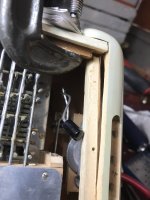32251
Active member
Here is a pic of an area of the accordion that is usually built too light. Under the leather strap on most vintage accordions is the cover for the bass mechanism. It’s usually just a thin flexible piece that screws to a very lightweight frame. There will be some sort of bumpers on each corner. If the instrument is set down too hard or bumps around in the case this frame is easily damaged. I have several units for repair that this has happened to. This can be fixed, but just remember to be careful.







